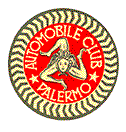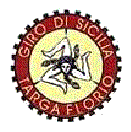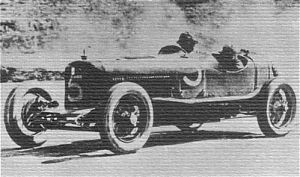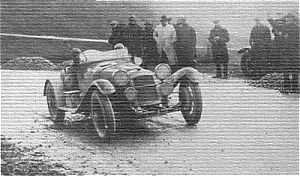 |
|
 |
The following text is taken from 'Maserati: A History' by Anthony Pritchard. This book first published in 1976 is sadly out of print. |
 |
I would like to thank Signor Gianfranco Mavaro of the Automobile Club Palermo for providing me with these official logos associated with this historic race. |
The Targa Florio is one of the world's oldest motor races and was run over circuit in the Sicilian mountains. |
The Targa Florio has a very special place in Maserati's history for it was in this race that the motor racing world first witnessed a car, adorned by the now famous trident, racing under the Maserati name. |
| 1926 - 22nd April - Madonie 336 miles:
Thirty-three cars were entered in the 1926 Targa Florio, the raucous Bugattis with an exhaust note likened to the tearing of calico; sports Alfa Romeos stripped for an out-and-out racing car event; quieter, more refined OM sports cars and, amongst the red of Italy, the first Maserati driven by its creator, Alfieri Maserati #5, with Guerino Bertocchi acting as riding mechanic. Technically the Maserati, the Tipo 26, was identical to its immediate predecessor, the 2-litre Diatto raced by the Maserati brothers in 1925. The twin overhead camshaft supercharged straight-eight engine had been reduced in capacity to 1,492cc (60 x 66mm) and in this form it was said to develope 120 bhp at 5,300 rpm, giving the Bologna car a maximum speed of close to 120 mph. The Tipo 26 had a wheelbase of 8ft 8in, a front track of 4ft 4¼in and weighed 1,591 lb. For the Sicilian race the normal streamlined tail was removed and it ran with a short, cut-off tail on which two spare wheels were mounted. On the front was the now famous trident badge which had been copied from a statue of Neptune in the main square at Bologna.  Alfieri Maserati at the wheel of the Tipo 26
Although the Targa Florio was a Formule Libre race to which cars of any capacity were admitted, the current Grand Prix formula was 1,500 cc with the additional requirements of a minimum weight of 600 kg and the fitting of two-seater bodywork. Riding mechanics were carried in the Targa Florio, but they had not been carried in Grand Prix racing since the start of the 1925 season. |
| 1927 - 24th April - Madonie 336 miles:
Three Maseratis were entered in the Targa Florio held on 24 April and one of these was the new Tipo 26B car which was driven by Alfieri Maserati #26. The Tipo 26B had a capacity of 1,980 cc (62mm x 82mm) and its power output of 145 bhp at 5,300 rpm was sufficient to endow it with a maximum speed of 125 mph. The Tipo 26, 1,500 cc cars were driven in Sicily by Ernesto Maserati #10 (went off the road at Collesano) and Count Maggi #14 (retired on the final lap). Once again the race proved largely a Bugatti benefit, eleven of the twenty-two cars entered were Bugattis and Materassi and Conelli took the first two places for Molsheim (the marque's third successive victory in the race). Nevertheless, Alfieri Maserati, who was a skilled and talented driver, did well to bring his car across the line in third place. Ernesto Maserati driving the Tipo 26 was forced of the road, the result of a broken front axle, and on Maggi, also in a Tipo 26, was forced to retire on the last lap with a broken chassis member. |
| 1928 - 6th May - Madonie 336 miles:
Five Maseratis were entered, described by Motor Sport as 'the greatest road race of the year'; the 2-litre Tipo 26B cars were driven by Ernesto Maserati, Diego De Sterlich/ Piero Bortolini #48 and Baconin Borzacchini, while 1.5-litre versions were handled by Luigi Fagioli and Marano. The race developed into a straight fight between the works teams from Bugatti and Alfa Romeo. Albert Divo won with his 2.3 litre Type 35B Bugatti from Campari's 6C-1500 supercharged Alfa Romeo and Chiron's 2-litre works Bugatti. W. F. Bradley, the doyen of motor-racing journalists, reported that the Maseratis were plagued by supercharger trouble and the highest placed Bologna car was Fagioli in seventh position. |
| 1929 - 4th May - Madonie 336 miles:
All the Maserati enteries retired, in fact there were only four finishers, but Borzacchini was able to derive some consolation for the team by breaking the lap record on only his first lap of the Sicilian circuit. |
| 1930 - 4th May - Madonie 336 miles:
Yet again in 1930 Maserati strove to win the Targa Florio, but were soundly trounced. The new Tipo 8C-2500 cars made their debut in this race and four were entered for Luigi Arcangeli #14, Borzacchini, Giuseppe Fagioli and Ernesto Maserati. The opposition included a strong entry of Bugattis and OMs and from Scuderia Ferrari (now entering cars on behalf of the Alfa works) one of the rebuilt P28 for Achille Varzi and 1,75Occ six-cylinder cars for Tazio Nuvolari, Giuseppe Campari and Count Aymo Maggi. |
| 1931 - 10th May - Long Madonie 363 miles:
On the 10th of May the Targa Florio was held over four laps of the 90 mile Long Madonic course because storm damage to roads and bridges prevented the use of the more usual 67 mile Madonie circuit. Maserati entered Tipo 8C-2500 cars for Fagioli #8, Biondetti and Dreyfus; Scuderia Ferrari fielded 8C 2300 Alfas for Nuvolari and Arcangeli and from Bugatti came a bright red Type 51 for Achille Varzi. Nuvolari won the race from Borzacchini (six-cylinder 1,750 Alfa) and Varzi. The Maseratis were out of luck; Fagioli #8, in third place on the first lap, crashed into the parapet of a bridge, Biondetti crashed on the second lap and Dreyfus, who went off the road several times because of his unfamiliarity with the course and was slowed by plug trouble, completed only three of the four laps. |
| 1932 - 8th May - Long Madonie 363 miles:
There were only sixteen runners in the 1932 Targa Florio run over eight laps of the 44.7 mile Little Madonie circuit, and the sole Maserati entry was Ruggeri #8 with a Tipo 8C-2800. Nuvolari, with an Alfa Romeo Monza, led throughout to win at 49.20mph from Scuderia Ferrari team-mate Borzacchini with a similar car and the Bugatti of Chiron/ Varzi took third place. Ruggeri brought his Maserati 8C-2800 across the line in fifth place, thirty-five minutes behind the winner.  Alfieri Maserati at the wheel of the Tipo 8C 2500 |
| 1937 - 25th May - Palermo Park 195 miles:
The race was held as a Voiturette race over the 3½ mile Parco delle Favorita circuit, the Maserati 6CMs driven by Francesco Severi, Count 'Johnny' Lurani, Ettore Bianco and Vittorio Belmondo taking the first four places, the winner averaging 66 mph. |
| 1938 - 25th May - Palermo Park 195 miles:
The race was once again held as a Voiturette race over the 3½ mile Parco delle Favorita circuit. In the absence of the English ERAs the race was dominated by Maseratis with a battle developing between the factory cars and the privateers. Early in the race, the 4CMs of Lurani and Bianco were involved in a collision forcing both cars to retire. The 6CMs of Aldo Marazza #30, who had just set the fastest lap, and Villoresi also had a slight coming together putting Marazza out of the race. The Maserati 6CMs driven by Giovanni Rocco #34, Raph and Luigi Villoresi, Battaglia and Soffietti / Baruffi went on to take the first five places, the winner averaging over 71 mph. |
| 1939 - 14th May - Palermo Park 195 miles:
The race was once again held as a Voiturette race over the 3½ mile Parco delle Favorita circuit, victory went to Luigi Villoresi #18 driving a 6CM and along with Piero Taruffi (6CM), Guido Barbieri (6CM), Paul Pietsch (6CM) and Capelli taking the first five places, the winner averaging over 84 mph. |
| 1940 - 23rd May - Palermo Park 195 miles:
The race was once again held as a Voiturette race over the 3½ mile Parco delle Favorita circuit, the Maserati 4CLs driven by Luigi Villoresi #26, Franco Cortese #24, Rocco, Bianco #6 and Arialdo Ruggeri taking the first five places, the winner averaging over 88 mph. The Maserati line up included the young Alberto Ascari in a 6CM #28, who crashed out early in the race. |
|
|
 |
|
To enter Enrico's Maserati Pages CLICK HERE! Copyright: Enrico's Maserati Pages - © 2002-2004. All rights reserved. |